Flat Fire (2005)
Flat Fire (2005)
Here we look at a large fire at a modern apartment block. The fire was reported in the roof of at 5:15pm on a Friday evening. The crews had difficulties with water pressure from hydrants and accessing the fire. The situation soon escalated, and at its height 80 firefighters were tasked to this incident.

The scene at the front of the apartments as four appliances tackle the blaze, including an aerial platform.

The situation at the rear of the four-storey building. It is clear that this is a serious incident. All the residents were successfully evacuated at an early stage. There is difficulty in bringing the fire under control, so more personnel and engines are requested.
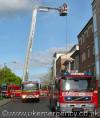
At the front, the Fire Brigade have closed the road. The wind is pushing the flames and smoke out of sight of the camera.

The seriousness of the incident prompts senior fire officers to arrive in their fire cars (shown). They plan the method of firefighting and take control of the incident.

A number of police officers have also arrived. They deal with crowd control, directing traffic and liaising with the evacuated residents, some of whom are just returning from work to find their homes on fire.

N612 WPY A police constable checks where the North Yorkshire Fire & Rescue Service Salvage & Environmental Control Unit should go as it arrives on blues and twos.
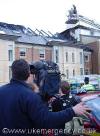
Such a large fire attracts the media. Press reporters and photographers are present, as well as local BBC and ITV television cameras and reporters. The first reporters on the scene are briefed by a UKev photographer as to what has happened before their arrival.
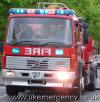
R513 MPY Boroughbridge’s water carriers arrives on blue lights and sirens to get more water to the scene.

YJ05 ACZ The local traffic police in a Volvo V70 T5 help control the traffic on the neighbouring main road. Water hoses have been placed across the road to get to hydrants and traffic has to slow as it drives over small ramps to get over them.

NX53 AYW Engines continue to arrive on blues and twos from outlying stations some hours after the start of the fire.

Firemen leap from their engine and don breathing apparatus kit.

P108 FEF Older engines from retained (un-manned) fire stations arrive to help with the effort. The change of shift at 6pm means that more firefighters need to be brought in before exhausted ones can leave.
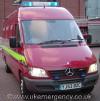
YJ53 BZC This is a specialist Incident Support Unit Mercedes Sprinter. Oddly it has no livery on the front, just the blue light bar on the roof.

The side view. This is the longest version of the Sprinter that is available.
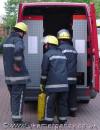
Firefighters in protective clothing and helmets remove oxygen cylinders from the shelving in the rear.
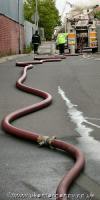
The fire is a short distance from a main river, so an engine is used to pump water from the river to where it’s needed (which can just be seen in the distance).

To stop other parts of the building catching fire, the Skylift is operated remotely to spray a wide angle of water over areas near the flames.

The following day: This is the situation as firefighters dampen down the properties and make safe any weak structures. This photograph was taken some 18 hours after the fire started, and is almost identical to the first photo in this album. 50 properties were damaged, with damage running into tens of millions of pounds.
